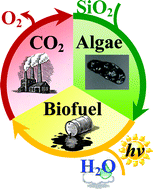With the aim of designing photobioreactors (PBR) based on a smart exploitation of microalgae for the production of biofuels and metabolites of interest, this paper describes a novel approach where cyanobacteria are entrapped within highly porous silica matrices. With this concept, it would be possible to work with a constant population of organisms for a continuous (and increased) photoproduction of metabolites, in contrast to “one-shot” uses of liquid cultures. Different hybrid materials based on porous silica gels are described with a special emphasis on finding the most appropriate immobilisation conditions for prolonged cell survival. It is found that an aqueous route based on acid-exchanged sodium silicate combined with the use of silica nanoparticles as a gel-strengthening species shows the best results with a high primary production rate post immobilisation and a preservation of the photosynthetic pigments of up to 35 weeks. Oxygen production, though very low, could be evidenced up to 17 weeks after entrapment, demonstrating the suitability of using porous silica matrices in PBR design.

You have access to this article
 Please wait while we load your content...
Something went wrong. Try again?
Please wait while we load your content...
Something went wrong. Try again?


 Please wait while we load your content...
Please wait while we load your content...